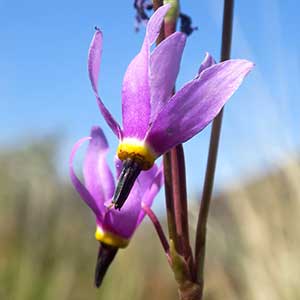Dodecatheon conjugens var. viscidum
Dodecatheon conjugens
sticky shootingstar
Bonneville shooting star, desert shootingstar, slim-pod shooting star
not obvious at anthesis;
roots whitish;
bulblets absent.
blades usually glandular-puberulent at least marginally.
3–13(–18) × 0.7–2.5(–4) cm;
petiole slender (at least proximally);
blade narrowly oblanceolate to spatulate or obovate, base usually not decurrent onto stem, usually abruptly tapering to petiole, margins entire, surfaces glabrous or glandular-puberulent.
usually glandular-puberulent proximally.
1–7(–10)-flowered;
bracts lanceolate to broadly lanceolate, 3–10 mm, glandular-puberulent.
usually glandular-puberulent.
1–5 cm, glabrous or glandular-puberulent.
calyx usually glabrous, sometimes glandular;
connective usually yellow at least apically, sometimes fading to whitish, sometimes maroon.
calyx light green to yellowish, sometimes finely purple-speckled or -dotted, 5–12 mm, glabrous or glandular-puberulent, tube 2–6 mm, lobes 5, 3–7 mm;
corolla tube yellowish with purplish red, thin, wavy ring, lobes 5, usually magenta, sometimes white, 7–25(–35) mm;
filaments usually distinct, yellowish or dark maroon, 0.5–1.5 mm, rarely partially connate and tube 0.5–1.5 × 1.5–5 mm;
anthers 5–9 mm;
pollen sacs usually maroon or yellow, sometimes yellowish and speckled maroon, rarely with reddish purple to purple speckles, connective usually maroon, sometimes yellowish or light blue to whitish, transversely rugose;
stigma not enlarged compared to style.
tan, often striped with purple, usually operculate, rarely valvate, cylindric-ovoid, 8–17(–22) × 4–6(–8) mm, glabrous;
walls thin, pliable.
without membrane along edges.
= 44.
= 44.
Dodecatheon conjugens var. viscidum
Dodecatheon conjugens
Variety viscidum is found throughout the northern range of the species from southeastern British Columbia, southern Alberta, and southwestern Saskatchewan to eastern Washington (Lincoln and Spokane counties), northern Idaho (as far south as Fremont County), and western Montana to the edge of the Great Plains. It appears to be disjunct near Tompkins, Saskatchewan (Looman 10304, OSC, UBC, UC, UTC); it approaches Dodecatheon pulchellum var. cusickii (not otherwise known from here); plants with both smooth and rugose connectives have been seen.
The distribution of the glands varies within plants. Most plants have at least the proximal portion of the scape glandular-puberulent; leaves and pedicels can be glandular or glabrous. Rarely is the entire scape glandular; these plants are confined mainly to the Waterton Lakes National Park area and are sometimes found elsewhere in Alberta. The calyx is rarely glandular. Even within the established range of var. viscidum, some populations may consist of both glandular and nonglandular individuals. Sometimes, only the pedicels have glands; in Wyoming such plants are assigned arbitrarily to var. conjugens. Plants with distinctly rugose connectives are termed here var. viscidum. H. J. Thompson (1953) assigned some Montana specimens with smooth or longitudinally wrinkled connectives to var. viscidum; here they are assigned to Dodecatheon pulchellum var. cusickii.
(Discussion copyrighted by Flora of North America; reprinted with permission.)
Varieties 2 (2 in the flora).
Both Dodecatheon conjugens and D. poeticum occur in proximity in the Columbia River gorge. Some specimens here assigned to var. conjugens may have scattered, minute glands on the pedicels that might indicate past hybridization with D. poeticum (e.g., G. N. Jones 6286, ORE; R. R. Halse 3790, OSC, WTU). Dodecatheon poeticum is densely glandular not only on the pedicels, but also on the calyx and scape. The type of minute glandular puberulence seen on var. conjugens found along the Columbia River west of The Dalles is somewhat similar to that seen on var. viscidum in western Montana and Canada. Some plants referred here to D. conjugens have slightly connate filaments that may indicate some intergradation with D. pulchellum var. pulchellum. This suggestion is supported by the tendency in the same plants to have narrower leaves.
Some newly emerged flowers tend to have connectives that are less rugose than normal. This is particularly true of some populations in southern Alberta and, to a lesser degree, in Saskatchewan.
(Discussion copyrighted by Flora of North America; reprinted with permission.)
1. Leaf blades, scapes, and pedicels glabrous. | var. conjugens |
1. Leaf blades, scapes proximally, and pedicels usually glandular-puberulent. | var. viscidum |
- Local floras:
BC,
CA,
OR,
WA
- Local Web sites:
CalFlora,
CalPhotos,
Flora NW,
PNW Herbaria,
Turner Photog.
WildflowerSearch
iNaturalist (observations)
USDA Plants Database
- LBJ Wildflower Center
- SEINet
- Plants of the World Online
- Encyclopedia of Life
- Wikipedia
- Google Image Search
